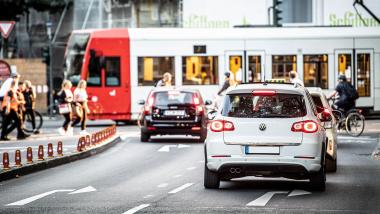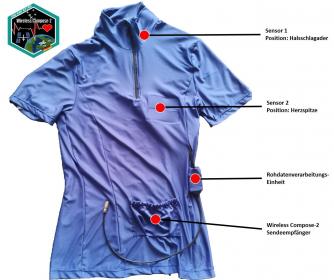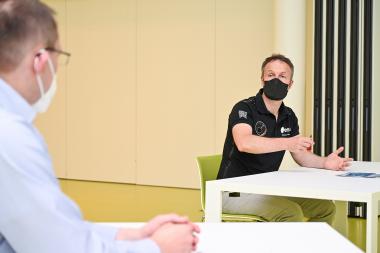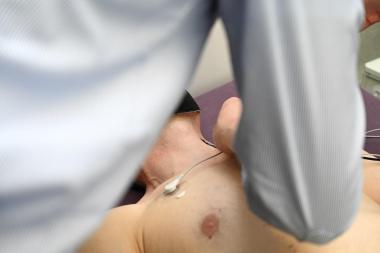DLR-Studie zu Corona und Mobilität: Häufiger im Auto und zu Fuß
- Die Veränderungen im Mobilitätsverhalten festigen sich.
- Autonutzung ist auf höherem Niveau als vor der Pandemie. Die deutlichsten Steigerungen sind bei den Fußgängern.
- Das DLR hat zum fünften Mal eine Befragung zur Mobilität in Deutschland durchgeführt.
Die Corona-Pandemie hat die Mobilität nachhaltig verändert: Wer unterwegs ist, nutzt seltener den öffentlichen Verkehr und steigt häufiger ins Auto. Diese Veränderungen verstetigen sich nun. Das hat eine Befragung ergeben, die das Deutsche Zentrum für Luft- und Raumfahrt (DLR) im November und Dezember 2021 durchgeführt hat. Ein weiteres Ergebnis: Die deutlichsten Steigerungen gab es bei den Fußgängern. 29 Prozent der Befragten erklärten, dass sie häufiger oder viel häufiger zu Fuß gehen als vor der Pandemie. Zum Vergleich: 20 Prozent sagten, sie nutzen häufiger oder viel häufiger das Auto. Das DLR untersucht seit Beginn der Pandemie das Alltags- und Reiseverhalten der Menschen in Deutschland. Die aktuelle Erhebung ist die fünfte einer Serie.
„Der positive Saldo bei den Fußgängern ist im Laufe der Pandemie kontinuierlich angestiegen. Darin spiegelt sich die hohe Bedeutung der Nahmobilität, also der Mobilität im Wohnumfeld. Diese ist in der Pandemie mit einer Einschränkung vieler Aktivitäten wichtiger geworden“, erklärt Dr. Claudia Nobis von DLR-Institut für Verkehrsforschung in Berlin. Von den Personen, die weniger mit öffentlichen Verkehrsmitteln fahren, gab etwa ein Viertel (26 Prozent) an, inzwischen mehr zu Fuß zu gehen.
Öffentliche Verkehrsmittel: „Angst vor Ansteckung tief verankert“
Die öffentlichen Verkehrsmittel sind der Verlierer der Pandemie. Das Unbehagen in kollektiv genutzten Verkehrsmitteln wie ÖPNV (Öffentlicher Personennahverkehr), Bahn, Flugzeug oder auch Carsharing bleibt bestehen. Im Gesamtbild kommt es im Verlauf der fünf Erhebungen nur noch zu geringfügigen Veränderungen. So war bei den öffentlichen Verkehrsmitteln das Unwohlsein zu Beginn der Pandemie am stärksten ausgeprägt; im Sommer 2020 ging es leicht zurück, um im Herbst 2020 erneut anzusteigen. Seither hat es zwar etwas abgenommen. Als Gesamtfazit lässt sich jedoch verzeichnen: „Die Angst vor Ansteckung und das Unbehagen in kollektiv genutzten Verkehrsmitteln hat sich tief in den Köpfen der Menschen verankert“, sagt Claudia Nobis. Aktuell fühlen sich 53 Prozent der Befragten im ÖPNV unwohler oder deutlich unwohler als vor der Pandemie. Ähnliche Zahlen wurden für die Bahn (51 Prozent) oder das Flugzeug (49 Prozent) ermittelt. Beim Carsharing liegt der Wert bei 33 Prozent.
Die abnehmende Bedeutung öffentlicher Verkehrsmittel im Corona-Alltag zeigt sich besonders beim Verlust der Stammkundschaft und dem rückläufigen Absatz von Zeitkarten: 27 Prozent der ehemaligen Zeitkartennutzenden haben ihr Abo inzwischen aufgegeben. 42 Prozent von ihnen nannten Corona als ausschlaggebend für die Kündigung. Die beiden Hauptargumente der ehemaligen ÖPNV-Nutzenden sind Bedenken hinsichtlich der Hygiene in den Fahrzeugen und die mangelnde Möglichkeit, Abstand zu anderen Fahrgästen zu halten. 30 Prozent der ehemaligen ÖPNV-Nutzenden gaben an, inzwischen vermehrt das Auto zu nutzen.
Ans Auto gewöhnt
Die Angewohnheit, ins Auto zu steigen und Busse oder Bahnen stehen zu lassen, hat sich verstetigt. Die aktuelle Befragung zeigt erneut, dass die Autonutzung auf einem Niveau ist, das deutlich höher liegt als vor der Pandemie. Vor der Corona-Pandemie hat etwa die Hälfte der Befragten ausschließlich das Auto genutzt. Der Anteil liegt aktuell bei 59 Prozent – und damit leicht unter dem Wert von 62 Prozent im Frühjahr. Generell abgenommen hat der Anteil der Personen, die im Sinne der Verkehrswende unterschiedliche Verkehrsmittel kombinieren. Vor Corona waren 31 Prozent mit einem Mix aus Auto, Rad und öffentlichen Verkehrsmitteln unterwegs. Mittlerweile hat sich der Wert bei 25 Prozent eingependelt.













